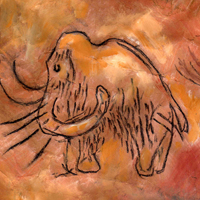
Hurray, more mammoth news! Just a couple of weeks after scientists reported that it's possible to make clones from frozen corpses - raising the (faint) possibility of resurrecting extinct animals that have been preserved in the permafrost, a paper in Nature today reports the first genome sequence of a mammoth - in fact the first genome sequence of any extinct species.
The DNA comes from two woolly mammoths found frozen in Siberia, which lived 20,000 and 60,000 years ago. Stephan Schuster from Pennsylvania State University and his colleagues extracted DNA from the animals' hair, and were able to sequence 3.3 billion base pairs of DNA.
It's just a draft sequence so far, and only covers around 70% of the entire genome, but the researchers have some interesting results already. First, they estimate that the mammoth genome is about 4.7 billion base pairs long (about half as long again as the human genome). Second, by comparing the sequence to that of modern elephants they found that mammoths were evolving only half as fast as primates do. Third, they found that the mammoth genome differs from that of elephants by as little as 0.6% (that's about half the difference between humans and chimpanzees).
The researchers are particularly interested in identifying which of those differences are responsible for making a mammoth into a mammoth. They've found a few spots in the genome that seem to be unique to mammoths. But they'll need to do more research to prove that these changes really are responsible for particular mammoth characteristics. They also hope to investigate how mammoths adapted to cold climate, and why they became extinct.
Onto the really important question: can we use the genome sequence to bring mammoths back to life? Henry Nicholls (author of Lonesome George, a book about a Galapagos tortoise thought to be the last of his kind) has written a feature in the same issue of Nature about exactly this (though unfortunately you need a subscription to read it). Nicholls explains that to produce a living animal you need to master the following steps: create a virtually error-free genome sequence; synthesise a full set of chromosomes from these sequences; engulf them in a nuclear envelope; transfer that nucleus into an egg that would support it; and get that egg into a womb that would carry it to term.
Rather depressingly, none of these steps is currently possible. But the existence of close living relatives (ie elephants) would make the job a lot easier than for dinosaurs, say. And the science is progressing incredibly fast, even since the film Jurassic Park was released in 1993. Back then, the longest genome that had ever been sequenced was that of a virus. Even less than a decade ago, sequencing a mammalian genome was a years-long, multimillion-dollar project. Now it can be done by a single lab in just a few months.
The next genome sequence we're likely to see from an extinct species is that of our own closest relative, the Neanderthal, and after that maybe the cave bear. Unfortuanately dinosaur genomes (because dinos lived so much longer ago) are still well in the realm of science fiction.
[The image is of a slightly more artistic attempt to bring the mammoth to life - modern cave art by Birgit Hannwacker.]